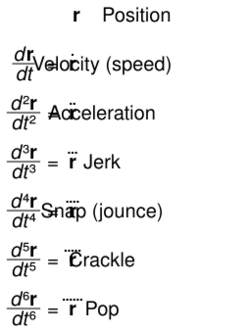Physics:Fourth, fifth, and sixth derivatives of position

In physics, the fourth, fifth and sixth derivatives of position are defined as derivatives of the position vector with respect to time – with the first, second, and third derivatives being velocity, acceleration, and jerk, respectively. The higher-order derivatives are less common than the first three;[1][2] thus their names are not as standardized, though the concept of a minimum snap trajectory has been used in robotics and is implemented in MATLAB.[3]
The fourth derivative is often referred to as snap or jounce. The name "snap" for the fourth derivative led to crackle and pop for the fifth and sixth derivatives respectively,[4] inspired by the Rice Krispies mascots Snap, Crackle, and Pop.[5] These terms are occasionally used, though "sometimes somewhat facetiously".[5]
Fourth derivative (snap/jounce)
Snap,[6] or jounce,[2] is the fourth derivative of the position vector with respect to time, or the rate of change of the jerk with respect to time.[5] Equivalently, it is the second derivative of acceleration or the third derivative of velocity, and is defined by any of the following equivalent expressions: In civil engineering, the design of railway tracks and roads involves the minimization of snap, particularly around bends with different radii of curvature. When snap is constant, the jerk changes linearly, allowing for a smooth increase in radial acceleration, and when, as is preferred, the snap is zero, the change in radial acceleration is linear. The minimization or elimination of snap is commonly done using a mathematical clothoid function. Minimizing snap improves the performance of machine tools and roller coasters.[1]
The following equations are used for constant snap:
where
- is constant snap,
- is initial jerk,
- is final jerk,
- is initial acceleration,
- is final acceleration,
- is initial velocity,
- is final velocity,
- is initial position,
- is final position,
- is time between initial and final states.
The notation (used by Visser[5]) is not to be confused with the displacement vector commonly denoted similarly.
The dimensions of snap are distance per fourth power of time (LT−4). The corresponding SI unit is metre per second to the fourth power, m/s4, m⋅s−4.
Fifth derivative
The fifth derivative of the position vector with respect to time is sometimes referred to as crackle.[4] It is the rate of change of snap with respect to time.[4][5] Crackle is defined by any of the following equivalent expressions:
The following equations are used for constant crackle:
where
- : constant crackle,
- : initial snap,
- : final snap,
- : initial jerk,
- : final jerk,
- : initial acceleration,
- : final acceleration,
- : initial velocity,
- : final velocity,
- : initial position,
- : final position,
- : time between initial and final states.
The dimensions of crackle are LT−5. The corresponding SI unit is m/s5.
Sixth derivative
The sixth derivative of the position vector with respect to time is sometimes referred to as pop.[4] It is the rate of change of crackle with respect to time.[4][5] Pop is defined by any of the following equivalent expressions:
The following equations are used for constant pop:
where
- : constant pop,
- : initial crackle,
- : final crackle,
- : initial snap,
- : final snap,
- : initial jerk,
- : final jerk,
- : initial acceleration,
- : final acceleration,
- : initial velocity,
- : final velocity,
- : initial position,
- : final position,
- : time between initial and final states.
The dimensions of pop are LT−6. The corresponding SI unit is m/s6.
References
- ↑ 1.0 1.1 Eager, David; Pendrill, Ann-Marie; Reistad, Nina (2016-10-13). "Beyond velocity and acceleration: jerk, snap and higher derivatives" (in en). European Journal of Physics 37 (6): 065008. doi:10.1088/0143-0807/37/6/065008. ISSN 0143-0807. Bibcode: 2016EJPh...37f5008E. https://doi.org/10.1088/0143-0807/37/6/065008.
- ↑ 2.0 2.1 2.2 Gragert, Stephanie; Gibbs, Philip (November 1998). "What is the term used for the third derivative of position?". Usenet Physics and Relativity FAQ. Math Dept., University of California, Riverside. http://math.ucr.edu/home/baez/physics/General/jerk.html.
- ↑ "MATLAB Documentation: minsnappolytraj". https://www.mathworks.com/help/robotics/ref/minsnappolytraj.html.
- ↑ 4.0 4.1 4.2 4.3 4.4 4.5 Thompson, Peter M. (5 May 2011). "Snap, Crackle, and Pop". Hawthorne, California: Systems Technology. p. 1. https://info.aiaa.org/Regions/Western/Orange_County/Newsletters/Presentations%20Posted%20by%20Enrique%20P.%20Castro/AIAAOC_SnapCracklePop_docx.pdf. "The common names for the first three derivatives are velocity, acceleration, and jerk. The not so common names for the next three derivatives are snap, crackle, and pop."
- ↑ 5.0 5.1 5.2 5.3 5.4 5.5 5.6 Visser, Matt (31 March 2004). "Jerk, snap and the cosmological equation of state". Classical and Quantum Gravity 21 (11): 2603–2616. doi:10.1088/0264-9381/21/11/006. ISSN 0264-9381. Bibcode: 2004CQGra..21.2603V. "Snap [the fourth time derivative] is also sometimes called jounce. The fifth and sixth time derivatives are sometimes somewhat facetiously referred to as crackle and pop.".
- ↑ Mellinger, Daniel; Kumar, Vijay (2011). "Minimum snap trajectory generation and control for quadrotors". 2011 IEEE International Conference on Robotics and Automation. pp. 2520–2525. doi:10.1109/ICRA.2011.5980409. ISBN 978-1-61284-386-5.
External links
 |
